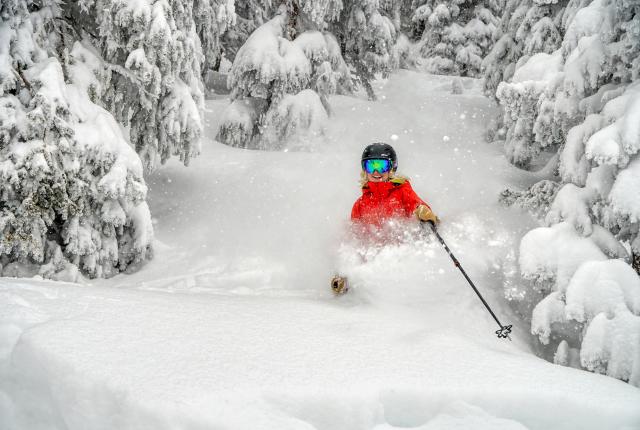Champagne powder rewards an adventurer at Ski Santa Fe. Photograph courtesy of Ski Santa Fe.
FAT SNOWFLAKES HAD BEEN FALLING over Ski Santa Fe for hours, speckling the pine trees and drifting to a boot-deep layer, before my first ski run in New Mexico. I dropped into a delightfully steep pitch that offered an open canvas of almost untracked powder. One turn floated into the next.
Months later, I capped that season by hiking up the ski area weeks after chairlifts had stopped running, enjoying a picnic on a spot of sunbaked grass, then skiing down on a patchwork of remnant snow, often in trees so thick the branches intertwined. Mud smeared the edges of my skis, and I had to hike the last quarter mile—but somehow, that day felt no less remarkable than the first.
When I mention to George Brooks, the director of Ski New Mexico, an industry nonprofit, that some of my best ski days have been in some of the worst conditions, he chuckles. “I think we’ve all had those days, and that’s why we keep coming back, trying to repeat those days, hoping lightning will strike twice,” he says. “There’s something magical about skiing.”
As ski season unfolds during this unprecedented time, skiers have more questions than what’s in the latest snow report. New Mexico’s ski areas worked with the state—led by a governor who is an avid skier—to craft covid-safe operating plans.
Small mountain communities like Angel Fire, Red River, and Ruidoso depend on winter sports enthusiasts for a significant economic boost, with alpine skiing’s statewide impact estimated at more than $142.3 million. But ski areas also offer outdoor recreation’s mental and physical health benefits, or “the respite of the mountains,” says Taos Ski Valley CEO David Norden.
“All of our ski areas in the state believe that,” Brooks says. “And that, over profit, is going to be driving ski areas to operate this winter.”
Read More: Editor's Letter: Ski Dreams
In addition, the National Ski Areas Association (NSAA) released Ski Well, Be Well, a guide to best practices for ski areas across the country that covers some familiar basics regarding face coverings, keeping distance, and cleaning often—hands included.
Limits on capacity will affect food service, retail shops, rentals, lift loading, lessons, and lift-ticket purchases. “Know before you go,” says Adrienne Saia Isaac, communications director for the NSAA. “Do a little research. And have a little empathy this season, because we’re all going through these new procedures. At the end of the day, we all just want to ski and do it in a way that’s safe.”
Even if every aspect of this season has changed, one thing doesn’t have to. “Once you’re on the slope, that experience is the same,” says Saia Isaac. “And it’s going to feel awesome.”
Paring back the trappings could recall the days of skiing before big base lodges, when we bundled up in our cars and hustled straight to the lifts. Back when Taos owner Ernie Blake ran the ski school and rental shop right out of his house. This could be a season to tap back into the roots of what draws us out on frigid mornings.
For those who stay at resorts, the scaled-back après-ski offerings may make for a quieter vacation spent curled up by the fire with a book or playing games with the kids.
“I think you’re going to hear people say, ‘This is what I love about skiing,’ and maybe even, ‘This is what I remember,’ ” Norden says. “It will be a season unlike any other, but for those who truly believe in and love the sport, it may shape up to be one of the great years—with uncrowded slopes and a real focus on the sport.”



